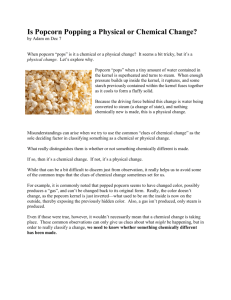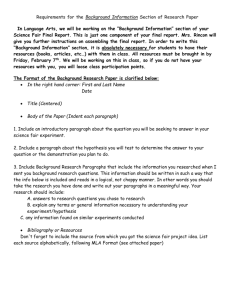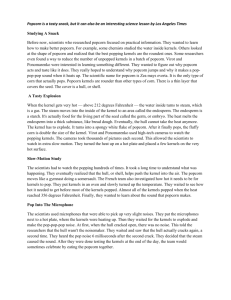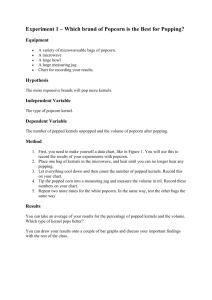POPCORN
advertisement
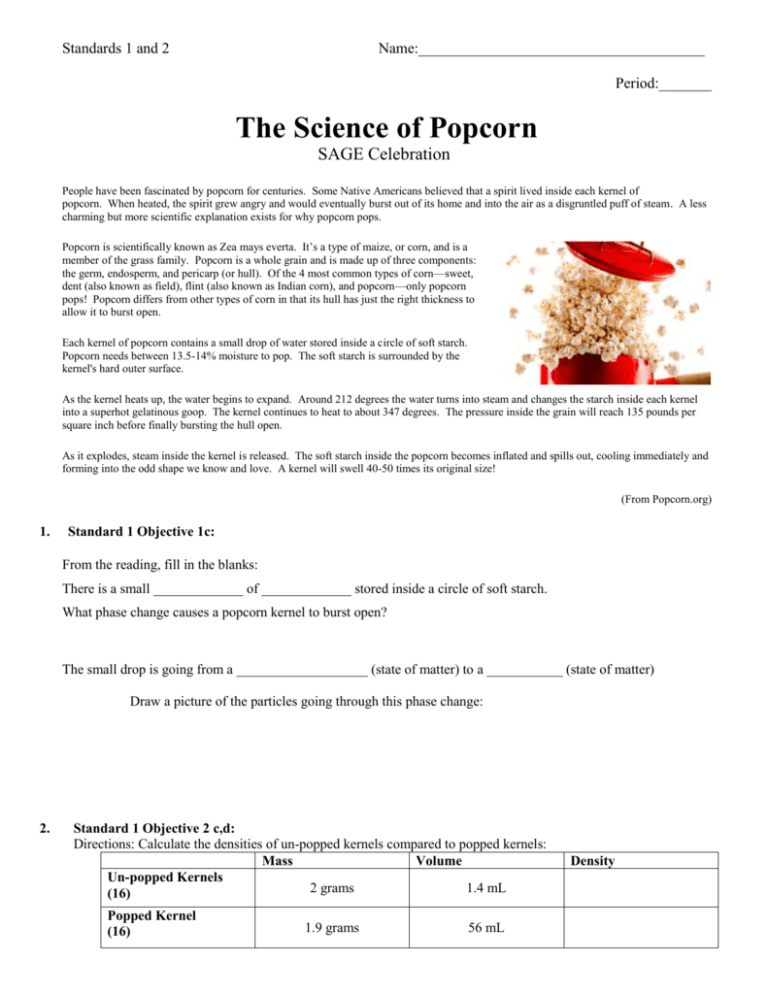
Standards 1 and 2 Name:______________________________________ Period:_______ The Science of Popcorn SAGE Celebration People have been fascinated by popcorn for centuries. Some Native Americans believed that a spirit lived inside each kernel of popcorn. When heated, the spirit grew angry and would eventually burst out of its home and into the air as a disgruntled puff of steam. A less charming but more scientific explanation exists for why popcorn pops. Popcorn is scientifically known as Zea mays everta. It’s a type of maize, or corn, and is a member of the grass family. Popcorn is a whole grain and is made up of three components: the germ, endosperm, and pericarp (or hull). Of the 4 most common types of corn—sweet, dent (also known as field), flint (also known as Indian corn), and popcorn—only popcorn pops! Popcorn differs from other types of corn in that its hull has just the right thickness to allow it to burst open. Each kernel of popcorn contains a small drop of water stored inside a circle of soft starch. Popcorn needs between 13.5-14% moisture to pop. The soft starch is surrounded by the kernel's hard outer surface. As the kernel heats up, the water begins to expand. Around 212 degrees the water turns into steam and changes the starch inside each kernel into a superhot gelatinous goop. The kernel continues to heat to about 347 degrees. The pressure inside the grain will reach 135 pounds per square inch before finally bursting the hull open. As it explodes, steam inside the kernel is released. The soft starch inside the popcorn becomes inflated and spills out, cooling immediately and forming into the odd shape we know and love. A kernel will swell 40-50 times its original size! (From Popcorn.org) 1. Standard 1 Objective 1c: From the reading, fill in the blanks: There is a small _____________ of _____________ stored inside a circle of soft starch. What phase change causes a popcorn kernel to burst open? The small drop is going from a ___________________ (state of matter) to a ___________ (state of matter) Draw a picture of the particles going through this phase change: 2. Standard 1 Objective 2 c,d: Directions: Calculate the densities of un-popped kernels compared to popped kernels: Mass Volume Un-popped Kernels 2 grams 1.4 mL (16) Popped Kernel (16) 1.9 grams 56 mL Density What happened to the mass when the popcorn kernel popped? Explain with data! What happened to the volume when the popcorn kernel popped? Explain with data! What happened to the density when the popcorn kernel popped? Explain with data! Would popcorn float in water? Explain your answer in at least 3 sentences: 3. Standard 1 Objective 3 You can smell popcorn coming from the room next door because the particles moved all the way to your nose. What natural process causes this phenomenon to occur? Draw the gas particles going through this process Where is there initially a high concentration of popcorn scent? What generally happens to the volume of an object when it is heated? Why is the fact that things expand when heated important in the art of popping popcorn? (At least 2 sentences) 4. Standard 2 Objective 1 a,c Dirt Clay Limestone Gravel Sand Density 1.22 g/cm3 1.6 g/cm3 2.56 g/cm3 2.0g/cm3 1.55 g/cm3 Particle Size .2 cm 1.2 cm 3.8 cm 2.4 cm .1 cm Draw how these materials would sort: Based on Density Based on Particle Size Add to your drawing where a kernel AND a piece of popcorn would settle in both of these towers. *Kernel = .5 cm *Popped corn = 5.8 cm - For densities see #2 Compare the density of a popcorn kernel to the density of 2 other earth materials: 5. Standard 2 Objective 2c How would a popcorn ball be considered a good model of the Earth’s inner core? How would a popcorn ball be considered a poor model of the Earth’s inner core? Which argument do you think is stronger? Would you use a popcorn ball to model the Earth’s inner core? Why?

